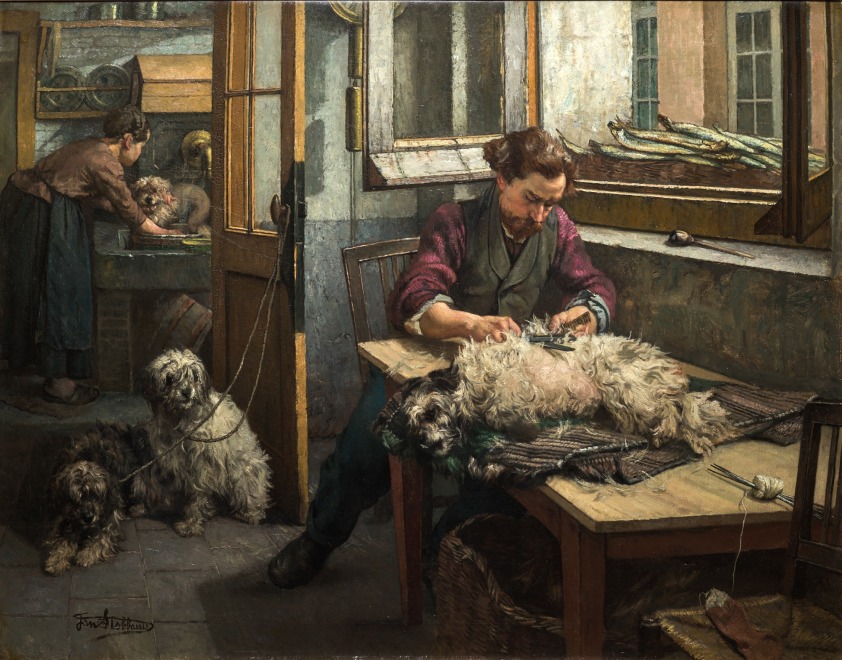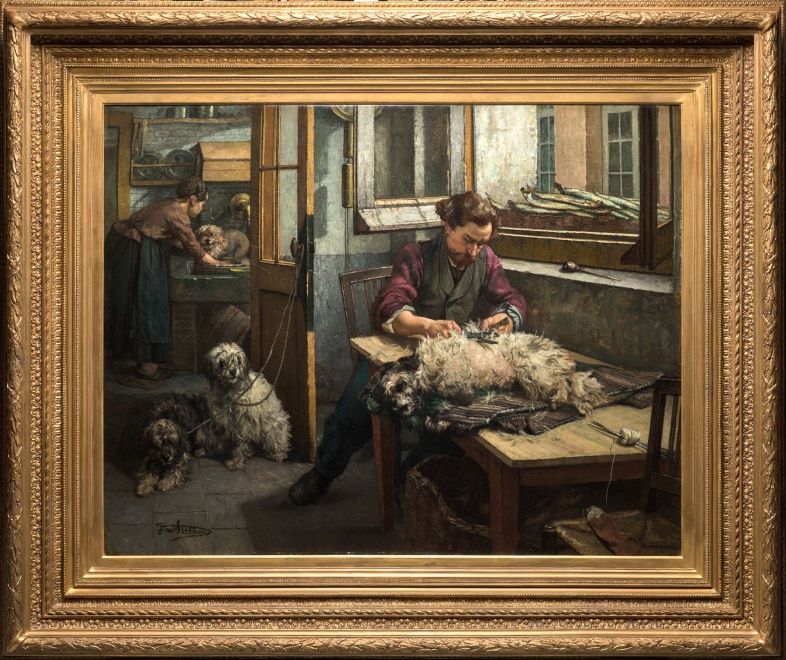Provenance
Léon Lequime, Brussels (acquired directly from the artist)
By descent to his son, Georges Lequime, Brussels (and sold, Brussels Galerie Georges Giroux, May 21, 1921, lot 49)
Pirson family, Brussels (acquired at the above sale)
By descent to a private collection, Brussels
Exhibited
Vienna, Universal Exhibition of Vienna (Weltausstellung Wien), 1873, no. 192 (as Der Hundescheerer)
Reims, Société des Amis des Arts, 1874, no. 982 (as Tondeur de chiens)
Berlin, Die akademische Ausstellung, 1874
Brussels, Exposition générale des Beaux-Arts (Salon de Bruxelles), 1875, no. 1133 (as Le tondeur des chiens)
Antwerp, Exposition Universelle des Beaux-Arts d'Anvers, 1885, no. 339 (as Tondeur de chiens. app. à M. Lequime)
Paris, Exposition Universelle, Rétrospective de l'Art belge, 1900
Liège, Exposition Universelle, Palais des beaux-arts, Rétrospective de l'Art belge, 1905
Paris, Salon d'Automne, Grand Palais des Champs-Élysées, 1907, no. 168 (as Le tondeur de chiens, collection M. G. Lequime, Bruxelles)
Brussels, Société Royale des Beaux-Arts, Le Salon de Printemps, 1908, no. 369 (as Le tondeur de chiens, collection Lequime)
Literature
Geroges Lafenestre, “Exposition de Reims,” in La chronique des arts et de la curiosité, no. 12, 21 mars 1874, p. 114.
Lucien Solvay, Revue du Salon, Bruxelles, Imp. A.-N. Lebègue, 1875, p. 224-225.
Camille Lemonnier, “Histoire des beaux-arts en Belgique,” in Cinquante ans de Liberté,
vol. III, Bruxelles, M. Weissenbruch, 1881, p. 241.
Jules Dujardin, À Propos d'Art, Bruxelles, B. Knoetig, 1892, p. 333.
Edmond-Louis De Taeye, Les Artistes belges contemporains, Bruxelles, A. Castaigne ed., 1894, p. 71.
Jules Dujardin, L'Art Flamand : Les artistes contemporains, vol. 5, Bruxelles, A. Boitte, 1896, p. 155.
Georges Eekhoud, “Jan Stobbaerts,” in L'art flamand & hollandais, Revue mensuelle illustrée,
no 1, 1909, p. 16, 25, 26.
Georges Eekhoud, Les peintres animaliers belges, Bruxelles, Librairie nationale d'art et d'histoire, 1911, ill. p. 56.
Pol de Mont, De Schilderkunst in België van 1830 tot 1921, 's Gravenhage, M. Nijhof, 1921, p. 178.
Paul Colin, La peinture belge depuis 1850, Bruxelles, ed. des Cahiers de Belgique, 1930, p. 97, ill. pl. 88.
Arthur Laes, “Les Animaliers,” in Paul Lambotte et al., Histoire de la peinture et de la sculpture
en Belgique, 1830-1930, Bruxelles/Paris, Editions G. Van Oest, 1930, p. 112.
R. Janssens, “Les Peintres de l'Intimité,” in Bulletins de l'Académie Royale de Belgique, 1933, vol. 15, p. 82.
Georges Marlier, Jan Stobbaerts 1838-1914, Bruxelles, De Lage Landen, 1944, pp. 34, 36, ill. pl. 6, p. 20.
Pierre Poirier, La peinture belge d'autrefois, Bruxelles, Renaissance du Livre, 1953, p. 145.
Georges Van Zevenberghen, “Jan Stobbaerts, 1838-1914,” in Bulletin Classe des Beaux-Arts, vol. 38, 1956, p. 38.
Catalogue note
Lost for over a century, The Dog Shearer (Le Tondeur de chiens) is one of Jan Stobbaerts’s most important paintings and an excellent example of nineteenth century Belgian Realism. The painting’s first owner was Léon Lequime, considered one of the greatest collectors in the history of Belgian art, who also became Stobbaerts’s most important patron. Legend has it that Lequime had already purchased the painting before King Leopold II of Belgium had a chance to acquire it. By the turn of the last century, Stobbaerts’s Le Tondeur de chiens had achieved such status as a pillar in the development of Belgian nineteenth century painting, that it was included in many, if not all major exhibitions and publications outlining the recent history of Belgian art.
Le Tondeur de chiens depicts an eccentric subject, which results in its immediate appreciation and popularity among viewers, and especially dog lovers. The scene takes place in the home of the dog groomer and his wife. Stacks of herring in a basket are drying on the windowsill; the groomer has put aside his pipe to allow him to focus on his “clients”. He combs and clips the curly fur of a shaggy dog, who appears frozen on the rag rug. Two additional resigned canines await their turn in the doorway, while a third is shampooed by the groomer’s wife. Stobbaerts has included a clue that she too has been interrupted; we see a ball of yarn and knitting needles on the table and a white thread dangling over the edge to reveal an unfinished sock. Nothing is wasted in this Belgian household; the dog’s fur drops in the basket under the table and is turned into yarn for knitting socks.
Stobbaerts was the beneficiary of a centuries old Flemish tradition in depicting realistic, genre subjects, scenes taken from everyday life; even dating back to the sixteenth century with Pieter Brueghel the Elder. This rich heritage paved the way for a painting like Le tondeur de chiens to easily be heralded as a masterpiece of 19th century Belgian Realism. Mention must also be made of Gustave Courbet, who made several trips to Belgium, where he was well received and exhibited such major works as The Stonebreakers (1849 and presumed destroyed in 1945). Courbet’s realistic subjects would not have gone unnoticed by Jan Stobbaerts, but perhaps it was Courbet’s larger than life persona and fame that provided the younger Stobbaerts with the confidence to paint (and exhibit) a subject he most likely witnessed first-hand – nothing historical, nothing mythological, nothing grandiose – just a scene from the daily life of a 19th century Belgian dog groomer.




